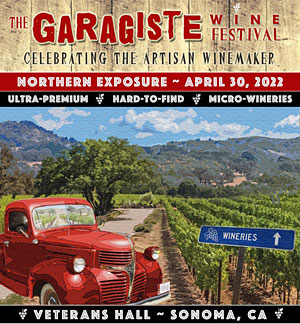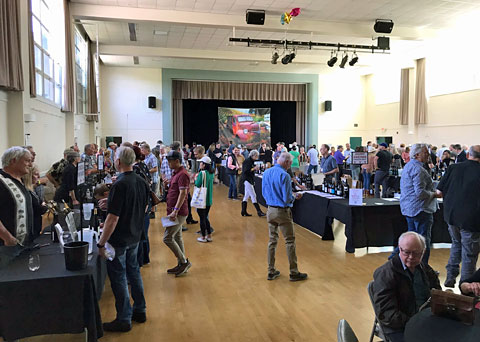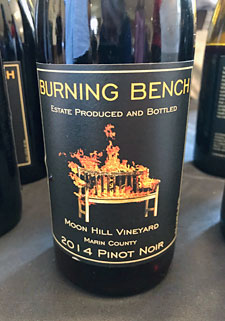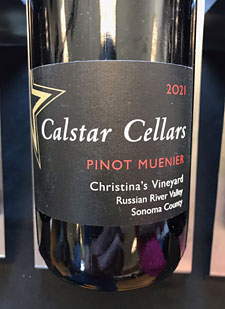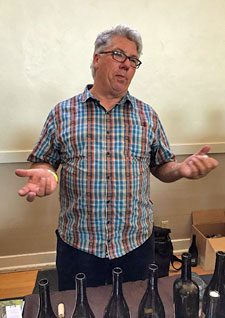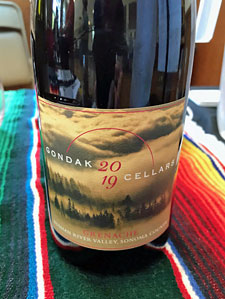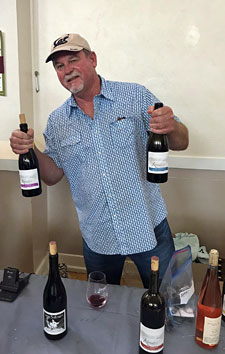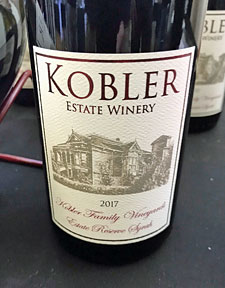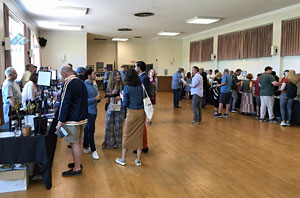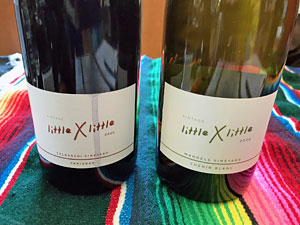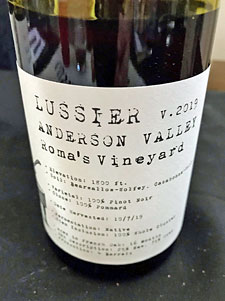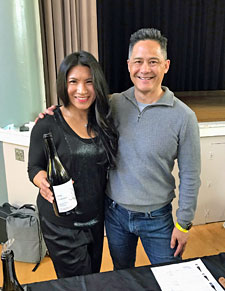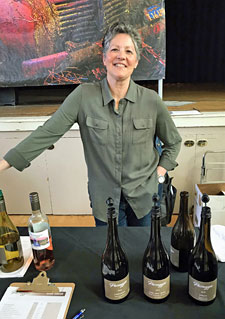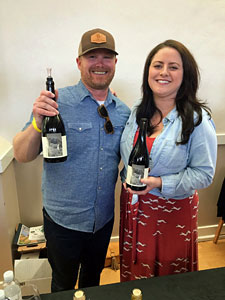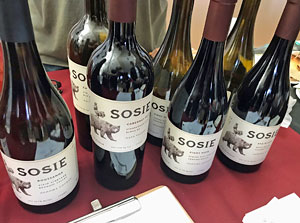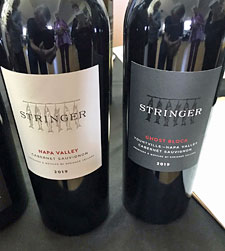Anthesis Wines
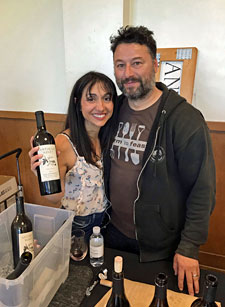 |
Winemaker Sandro Tamburin and his wife Breanna are the proprietors of Anthesis, and their first vintage was from 2016. Breanna is the daughter of Ray D’Argenzio of D’Argenzio Winery in Santa Rosa – it’s the sister winery of Anthesis and the wines are made there. I tasted three wines at the Anthesis table, and I thought that both of their orange wines – white varieties fermented on the skins like reds – were highlights. The fruit for both came from Alder Springs Vineyard in far northern Mendocino County. The 2016 Alder Springs Vineyard Picpoul Blanc was fermented with 50% whole clusters, spending 15 days on skins – this had savory aromas along with stone fruit and orangepeel notes, a terrific texture with bright acidity and a touch of chalky tannins on the finish. The 2016 Alder Springs Vineyard Falanghina was 100% whole-cluster fermented for 30 days, and though not quite as expressive as the Picpoul, it also featured savory, earthy, and spicy character, with a bit more grip on the finish.
Burning Bench Cellars
Burning Bench vintner David Mease’s Moon Hill Vineyard is one of the few vineyards located in Marin County, located in the hills between San Geronimo and Nicasio. The small estate vineyard was planted about 20 years ago with 115, 667, 777, and 828 Pinot Noir clones. I used to enjoy tasting David’s wines at the old Marin Wine Celebration tastings – those events have not been held for a number of years so it was good to see him here. He poured a 2008 Pinot plus a vertical of 2014-2018, and I thought a couple of them showed particularly well. The 2014 Moon Hill Vineyard Pinot Noir featured bright red fruit, earth, and tea leaf aromas, with a light and lively mouthfeel and finish. The 2017 Moon Hill Vineyard Pinot Noir showed more spice on the nose along with red fruits and orangepeel, a bit bigger texture than the 2014 and moderate tannins – while nice now, this wine should benefit from more time in the cellar.
Calstar Cellars
Vintner Rick Davis has made wine for a number of well-known producers including Flowers, Londer, and Halleck – Calstar is his own label, launched in 2001. Based in Santa Rosa, Calstar makes wines from several grape varieties, sourcing much of the fruit from cooler-climate sites. Among the highlights was the 2021 Christina’s Vineyard Pinot Meunier from Russian River Valley, which displayed both red and black cherry aromas, spice and dried herb, no overt oak component, and fine tannins – needs more time in the bottle but plenty of potential. Not surprisingly, the 2018 “Alta Zin” Cardanini Estate Zinfandel from El Dorado County was quite a contrast, with bolder boysenberry and darker fruit along with spice and earth notes – medium-bodied and nicely balanced with good structure.
Cazadero Winery
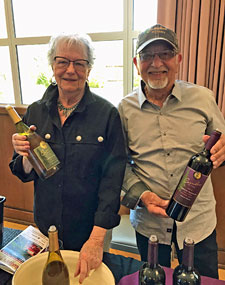 |
Frank & Ronita Egger established their winery in 2008, and it specializes in Chardonnay, Pinot Noir, and Cabernet Sauvignon from the western Sonoma Coast, not far from where Frank’s grandfather planted a vineyard in the 1920s. The Cazadero wines are made in Healdsburg. The 2019 Parmeter King Ridge Vineyard Chardonnay, from the Fort Ross-Seaview AVA, showed bright citrus and green apple fruit, spice, and floral undertones, medium-bodied with a lively finish. I tasted two of the four Cabernets being poured at the table, and both were standouts. The 2011 Mountain Terraces Vineyard Cabernet Sauvignon, from the Moon Mountain AVA high above Sonoma Valley, displayed currant and plum, dried herbs, earth, and spice aromas, with medium weight, good acidity, and nicely-resolved tannins. The 2015 Bei Ranch Cabernet Sauvignon, from a site near the Egger’s property on the Sonoma Coast, was even better, with darker color and fruit profile, lots of spice and herb notes, little overt oak influence, and fine tannins – delicious now but should continue to develop nicely with more cellaring.
Cutruzzola Vineyards
Frank Cutruzzola and Lisa Miller are the proprietors of Cutruzzola Vineyards. Their estate Riven Rock Vineyard, planted in 2001 and 2006 to Riesling and Pinot Noir, is just a few miles from the coast near Cambria in San Luis Obispo County. The winery’s first vintage was in 2009. Riesling is a specialty of Cutruzzola, and their 2018 Riven Rock Estate Riesling was a favorite at the tasting, with citrus, petrol, spice, and floral aromas, a fine balance of acidity with just a hint of residual sugar, medium-bodied with a lively mouthfeel and finish. I also particularly enjoyed the 2017 Riven Rock Estate “Giacomino Reserve” Pinot Noir – this had a savory character, along with red fruit, forest floor, a touch of spice, with fine acidity and balance.
Dane Cellars
The first wines from Bart Hansen’s Dane Cellars came from the 2007 vintage. Bart has worked for Kenwood and Benziger, and has focused on Dane full-time since 2018. Specialties include Chenin Blanc, Zinfandel, plus Rhône and Bordeaux varieties, mostly from Sonoma Valley vineyards. The 2019 Buddha’s Dharma Vineyard Chenin Blanc from Mendocino County was a real highlight, with bright, savory pear fruit plus touches of flowers and stony minerals, and a nice balance of richness and acidity. The 2019 “Valeria” Red Field Blend was my favorite of several good red wines at the Dane table. This one is a blend of Zinfandel, Grenache, Petite Sirah, Carignan, and Mourvèdre from Sonoma Valley, and it displayed brambly red fruit, earth, and spice aromas, medium-full bodied with firm tannins that will benefit from further bottle age.
Gondak Cellars
Proprietor / winemaker Will Gondak launched his eponymous winery with the 2015 vintage. He works with both white and red Rhône grape varieties plus a little Arneis, sourced from sites in Russian River Valley and Knights Valley. Both of my favorites from the Gondak table were sourced from Russian River Valley vineyards. The 2021 Catie’s Corner Vineyard Grenache Blanc had bright pear and stone fruit aromas plus floral notes and undertones of spice, with good body and a lively, fresh finish. The 2019 Campbell McKinney Vineyard Grenache showed a refreshingly light-handed approach, with red fruit, spice, and a touch of herbs, vibrant acidity and a clean finish with fine tannins.
Kendric Wines
Kendric’s Stewart Johnson planted and farms his Petaluma Gap vineyard located in northern Marin County – he grows mostly Pinot Noir, plus Chardonnay, Viognier, and Syrah. His family also grows Sangiovese in Amador County’s Shenandoah Valley. The first vintage of the Kendric wines was in 2004. (Disclosure – I’ve helped bottle some of the Kendric wines) The 2019 Estate Chardonnay displayed apple and pear aromas with floral and earthy undertones and a touch of spice, medium-bodied with a creamy yet lively mouthfeel and finish. The 2018 Estate Pinot Noir was savory and earthy, with black cherry fruit, hints of flowers and spice on the nose, and fine balance. My favorite at the Kendric table was the 2018 Estate Syrah, which was co-fermented with Viognier skins – this had upfront meaty aromas followed by dark berry fruit, spice, and a touch of black pepper, medium-full body with good acidity and structure. A very nice cool-climate Syrah that will benefit from cellaring.
Kobler Estate Winery
The Kobler family planted Rhône and Burgundian grape varieties in their vineyard in Green Valley of Russian River Valley in 1996, and they founded their own label in 2010. Michael Kobler manages the vineyard while his sons Mike and Brian run the winery. The 2020 Kobler Family Vineyards Rosé of Syrah, made in stainless steel, was one of my favorite rosé wines of the tasting – very light color with floral and strawberry aromas, vibrant texture and a fresh finish. The 2018 Bacigalupi Vineyards Pinot Noir showed classic Russian River Pinot character with its cherry, cola, and spice aromas, medium weight and fine tannins. A particular highlight was the 2017 Kobler Family Vineyards “Estate Reserve” Syrah – savory herbal notes along with pepper and dark berry fruit, this was fairly full-bodied with firm tannins, an impressive young Syrah that deserves further aging.
|
little x little wines
Longtime friends Will Gondak and John Mulroy teamed up to establish little x little wines in Sonoma County, one of the newest labels at this event. Gondak Cellars and little x little shared a table at the tasting. The 2020 Mangels Vineyard Chenin Blanc from Suisun Valley in Solano County featured apple, stone fruit, and floral aromas with medium weight on the palate and a lively mouthfeel and finish. The 2020 Teldeschi Vineyard Carignan, from Ray Teldeschi’s vineyard in Dry Creek Valley, was earthy and brambly, with raspberry, spice, and stony mineral notes, medium-bodied with firm tannins on the long finish.
Lussier Wine Company
G.W. Lussier has worked at Pahlmeyer and Williams Selyem, and he launched his eponymous label with the 2019 vintage. He sources fruit from cool-climate vineyards in Anderson Valley and Green Valley of Russian River Valley, producing Chenin Blanc and Pinot Noir. The 2020 Green Valley Vineyard Chenin Blanc from Solano County Green Valley, was made in neutral oak, and displayed apple, spice and earth aromas with floral undertones, nice texture and a lively finish. A standout was the 2019 Roma’s Vineyard Pinot Noir from Anderson Valley – fermented entirely with whole clusters, this was very savory, with red fruit, flowers, and touches of tea leaf and forest floor, fine structure and a lively finish. Tasty now, this should develop nicely with further bottle age.
Marchelle Wines
Marchelle is a collaboration between Kevin & Michelle Lee and winemaker Greg La Follette and his wife Mara – the winery name is a combination of Mara and Michelle. They specialize in wines from old vines, including Colombard, Cinsaut, Carignan, and Zinfandel from Russian River Valley and Lodi. All of the wines I tasted at the Marchelle table were sourced from the Mokelumne River AVA of Lodi, and two in particular stood out to me. The 2019 Jessie’s Grove Vineyard Carignan includes 8% Monbadon (also called Burger), and featured bold plummy fruit, earth, and lots of spice on the nose, with a medium-big mouthfeel and firm tannic finish. The 2019 “Old Vine Red” is a blend of 47% Carignan, 30% Cinsaut, 23% Zinfandel from Royal Tee Vineyard, Bechthold Vineyard and Spenker Ranch, all among Lodi’s oldest vineyards. Complex red and black fruit, earth, spice, and stony mineral aromas, this was a big yet lively wine with fine structure.
Montagne Russe Wines
Montagne Russe is the label of Kevin Berofsky, who focuses on Chardonnay, Pinot Noir, and Syrah, sourced from cooler-climate growing regions, including the Sonoma Coast and Petaluma Gap. Kevin made his first commercial wines about ten years ago. (Disclosure – I’ve helped bottle some of the Montagne Russe wines in the past) The 2019 “Dragon’s Back” Pinot Noir from Black Knight Vineyard in the Sonoma Coast was a lighter-weight Pinot that featured aromas of floral red fruit aromas with a lively texture and finish. The 2018 Roberts Road Pinot Noir from the Petaluma Gap was a contrast, earthy and herbal, with a black cherry fruit profile and bigger structure. Best of all was the 2018 Old Lakeville Road Syrah, also from the Petaluma Gap – this displayed savory, meaty aromas along with black fruit, licorice, and stony minerals on the nose, with plenty of structure and a firm tannic finish that suggests additional cellaring will benefit this wine.
Passaggio Wines
Passaggio owner / winemaker Cindy Cosco launched her wine label in 2007 and she makes her wines on San Francisco’s Treasure Island. She works with a number of grape varieties and sources fruit from many regions – mostly from Sonoma Valley, Clarksburg, and Lodi. (Disclosure – I’ve helped bottle some of the Passaggio wines) The 2021 Sonoma Valley Sangiovese Rosé, from Albini Vineyards, was made in stainless steel and had bright floral aromas along with strawberry and herbal notes, with a lively mouthfeel and finish. Among the Passaggio red wines, the 2017 “GSM Red Wine” was my favorite. Sourced from vineyards in Sonoma and Clarksburg, this is 43% Syrah, 29% Grenache, and 28% Mourvèdre, and had red fruit, spice, and a stony mineral component, with good acidity and structure.
Pine Mountain Vineyards
Pine Mountain’s inaugural vintage was in 2018, and fruit for their wines comes from their high-elevation 36-acre estate vineyard in the Pine Mountain-Cloverdale Peak AVA near the Sonoma-Mendocino border. The vineyard is planted to Sauvignon Blanc, Cabernet Franc, and Cabernet Sauvignon. My favorite of the Pine Mountain wines was the 2019 Estate Cabernet Franc. From 100% Cab Franc, this featured currant and plum fruit with a touch of spice and a big herbal component, a fairly full-bodied but lively texture, and good structure for development with additional bottle age.
Ricci Vineyards
The family-run Ricci label was launched by Dale Ricci and Tyler Kohfeld in 2018. The estate vineyard in Carneros is the only site in California growing the Austrian grape variety St. Laurent, and it also includes Chardonnay and Pinot Noir. The wines are made by Michael Lancaster. The direct-press 2021 Estate Rosé of Pinot Noir had subtle red fruit and tropical fruit aromas with floral undertones, vibrant acidity, and a fresh, clean finish. The 2019 Carneros Chardonnay, made in stainless steel and neutral oak, was a lighter-style Chard, with green apple and a touch of spice on the nose, and a lively mouthfeel and finish. The 2018 Estate St. Laurent was a standout –red fruit, earth, flowers, and a savory, meaty element, medium-bodied with fine tannins, very different and intriguing. The 2020 “Cesta Cuvée,” a blend of 57% Pinot Noir and 43% St. Laurent, was another distinctive wine, with bright cherry, earth, and spice aromas, medium weight with fine tannins.
Sosie Wines
Winemaker Scott MacFiggen and Regina Bustamante founded Sosie in 2015. They source fruit from a number of noted vineyards in Sonoma and Napa counties, and Rhône varieties, Pinot Noir, and Bordeaux varieties have been the winery focus. I thought two of the Sosie wines I tasted were real standouts. The 2017 Spring Hill Vineyard Pinot Noir, from a Petaluma Gap site, had earthy and spicy black cherry aromas along with tea leaf notes, medium weight on the palate, and good structure. The 2016 “Block K5” Stagecoach Vineyard Cabernet Franc from Napa Valley displayed upfront herbs, black cherry and plum fruit, with touches of spice and jalapeño in the background, a medium-full bodied mouthfeel and a firm tannic finish. Both wines should benefit from additional cellaring.
Stringer Cellars
Stringer owner / winemaker Casey Stringer worked at wineries in California, Oregon, and New Zealand before establishing his own label with the 2015 vintage. Fruit sources are mostly from Napa Valley and also from Sonoma and Santa Barbara counties. The 2019 Kick Ranch Sauvignon Blanc, from a site in Sonoma’s Fountaingrove District AVA, was made in neutral oak, and showed citrus and herb aromas with floral undertones, medium body with a lively finish. The 2019 Napa Valley Cabernet Sauvignon – 96% Cabernet Sauvignon and 4% Petit Verdot – was sourced from several vineyards. Bright currant and plum fruit, spice, and understated vanilla/oak, this had good structure and moderate tannins. The barrel fermented 2019 Ghost Block Yountville Cabernet Sauvignon was a bigger, bolder wine yet more focused, with dried herb, spice, and plum and darker berry fruit, great texture on the palate with firm tannins – this deserves more bottle age for further development.
The Grenachista Wine Company
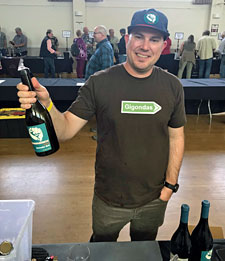 |
Casey Graybehl has worked for wineries in Napa and Sonoma, and he launched his Grenachista label in 2013. The focus is exclusively on Grenache – both Blanc and Noir – and the winery works with vineyards in different parts of Northern California to produce a number of bottlings and styles of Grenache. I started out with the 2021 Grenache Piquette (piquette is generally made by adding water to grape pomace and fermenting it into a low-alcohol beverage) – this was distinctive, light and a bit thin in texture, with subtle red fruit and earth aromas and the slight fizz typical of this style. The 2021 Sonoma Valley Grenache Rosé was another wine with aromas that were more subtle than bold, with strawberry and watermelon notes and floral undertones, fine acidity, and a bright, fresh finish. The 2019 Mounts Family Vineyard Grenache Noir, from Dry Creek Valley, fermented with whole clusters, showed a light hand with this variety and featured bright strawberry, spice, and dried herbs on the nose, with medium-light body and a lively mouthfeel and finish.
Weatherborne Wine Corp.
Cris Carter established his Weatherborne label in 2012 in Santa Barbara County but he’s since moved to Mendocino County, where the fruit for most of his recent wines has been sourced. Cris purchased property near Philo in Anderson Valley and plans to plant an estate vineyard there. The 2019 Alder Springs Vineyard Grenache, from far northern Mendocino County, displayed very floral aromas along with red fruit, earth, and spice in support, medium weight with fine tannins on the finish. The 2019 Anderson Valley Pinot Noir, sourced from Balo Vineyard near Philo, had a stony mineral character, plus red cherry fruit, tea leaf, and spice, with a lively mouthfeel and finish.
|


